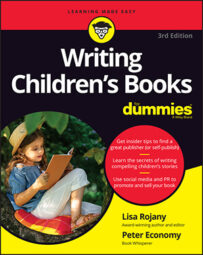Words are fun. And what better way to have fun with words than to write a children’s book? You have far more freedom to play around with words when writing children’s books than you do when writing other kinds of books. The sky is truly the limit.
Use some of these common methods to have fun with words:
Alliteration: The initial consonant sounds of words two or more times in a line or sentence creates a rhythmic component to the writing. For example, “She stewed in her soft and simple shoes.”
Assonance is similar to alliteration, but uses vowel sounds instead of consonant sounds.
New writers often fall into the trap of using alliteration or assonance in naming characters, which is amateurish and displays a lack of skill in properly developing a character. It also screams: “I am new at this and think it’s so cute!”
For example, Billy Bully. If Billy is a bully, you should be showing him bullying and not just giving him a label to make your reader “get” that he is a bully. In other words, alliterative names are annoying as all get-out. Just say no.
Parallelism: Repeating similar thoughts in two different phrasings. There are variations on the theme:
Antithetical: When the second phrasing is the exact opposite of the first: “The good boy did his homework and cleaned his room; the bad boy threw his homework in the trash and dumped his dinner on the floor.”
Synonymous: When the second phrasing is almost identical to the first. “The warm sun warmed the faces of the children at play; the children’s faces glowed with the first rays of the sun.”
Be careful not to use parallelism to repeat yourself or insert redundancies into your writing. For example, “The good boy did his homework on time, completing all his tasks in a timely manner.” This is unnecessary repetition as both sides of the comma relay the exact same information. That is not fun; that is verbosity that needs to get cut. Choose one and lose one.
Refrain: A line or group of lines are repeated throughout a story. Consider the following lines, repeated throughout Dr. Seuss’s Green Eggs and Ham: “I do not like green eggs and ham. I do not like them, Sam-I-am.”
Polyptoton: The same word is repeated in different forms. “The ogre was strong, and he revealed his full strength as he toppled tree after tree in the forest, headstrong to the very end.”
Metaphor: Comparing two unlike things using any form of the verb to be. “The color blue is a cold, winter’s day — snow forming drifts on the sides of the road and icicles hanging from the roof of the house.”
Simile: Comparing two unlike things using like or as. “His anger was like a summer’s storm — arriving quickly and without warning, then soon passing without a trace.”
Anthropomorphism: Human motivations, characteristics, or behavior appear in inanimate objects, animals, or natural phenomena. For example, Thomas the Tank Engine (from The Railway Series by Rev. W. Awdry) is an anthropomorphized train with a human face, feelings, and emotions. He’s always getting into all sorts of trouble.
Personification: Human qualities appear in an animal or object. “Flowers danced in the field.”
Some children’s book writers make up words. Dr. Seuss (whose real name was Theodor Geisel) was a master at this; his made-up words were understood because of what was happening in the story.
Lewis Carroll, author of Alice’s Adventures in Wonderland and other stories and poems, ranks up there with the very best, making up words that could be evocative because they were told in a particular context, allowing the reader to envision what they meant.
Ninety percent of the time this tactic does not work for beginning writers. Usually, made-up words are a sign of laziness (unwillingness to find the right real word or combination of words) or an attempt to insert humor that ends up feeling forced (as in your idea of a funny, made-up word does not necessarily jibe with a child’s).
So steer clear of wordplay that involves making up words. Your readers will be glad you did.

